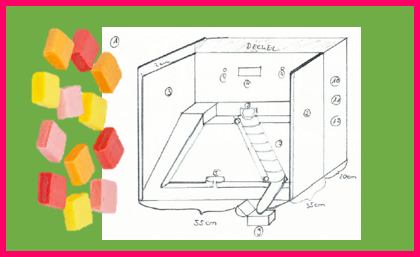Julie Poirier had just finished her master’s thesis when she already got the okay for her job as a doctoral student in subproject A16, and now she is not even registered at university in Bochum, but already has her first treasure chest grant in her pocket. Congrats!
While her project, A16, examines infants Julie experienced during the testing session once more how difficult it is to get the babies’ attention for the test duration. For the investigation of older children or even teenagers there was no agenda yet, and that has kept her busy. Together with a graphic designer friend, she now realizes an idea how a wide range of ages can be won for her tests! They are building a scientific pinball machine, a behavioural study box that the test persons will really enjoy. Julie explains her idea like this:
Title: “Candy Mountain Treasure Hunt – Assessing Appetitive Extinction in Human Childhood and Adolescence”
For most pupils, learning seems easy, forgetting sometimes much more difficult. During extinction learning, information is not just simply deleted in the brain – but what happens instead? To assess the mechanisms and the development of extinction learning during childhood, an appetitive operant conditioning paradigm, the “Candy Mountain Treasure Hunt”, was designed. It allows the examination of acquisition, extinction and renewal in children using a “Skinner Box”, typically utilized in animal studies, which was modified to fit children’s interests. The box will be manufactured in a mechanistic way to enable a real-life experience and to further validate the virtual Balloon Popping Task (adapted from Happaney & Zelazo, 2004) used in the subproject 16 studies. Furthermore, applying the task in children aged four to six we will be able to extend the preconceived age range in the A16 project, thus covering another critical, sensitive period during human development. Moreover, the box allows the establishment of a methodological link towards animal studies such as in pigeons and rodents, leading to enhanced translation of results between the human and animal domains. Overall, the box itself and the related self-reliant paradigm will enable the author to gain important additional insight to extinction learning and underlying behavioral processes in children. In future studies, the box can be applied in older children and adolescents as well to cover further important developmental periods.
To the best of my knowledge, there are currently no studies on appetitive extinction in adolescenct humans. Despite the general lack of studies on appetitive extinction in human adolescents, leastwise some evidence has emerged from studies in rodents: Kim et al. (2011) conducted a study assessing changes in adolescent rats by examining conditioned fear extinction. Adolescent rats exhibited an almost complete failure to maintain extinguished behavior thus showing heightened renewal as compared to preadolescent and adult rats. We want to transfer this finding into the animal domain to examine whether this U-shaped extinction learning curve proves true in human children and adolescents as well.
Happaney, K., & Zelazo, P. D. (2004). Resistance to extinction: A measure of orbitofrontal function suitable for children? Brain and Cognition, 55(1): 171–184. doi:10.1016/S0278-2626(03)00270-7
Kim, J. H., Li, S., & Richardson, R. (2011). Immunohistochemical analyses of long-term extinction of conditioned fear in adolescent rats. Cerebral cortex, 21(3): 530–538. doi:10.1093/cercor/bhq116
The SFB 1280 has set up a budget for the realization of its young researchers’ own research ideas. With the “treasure chest” we finance convincing and independent study concepts of young scientists.

